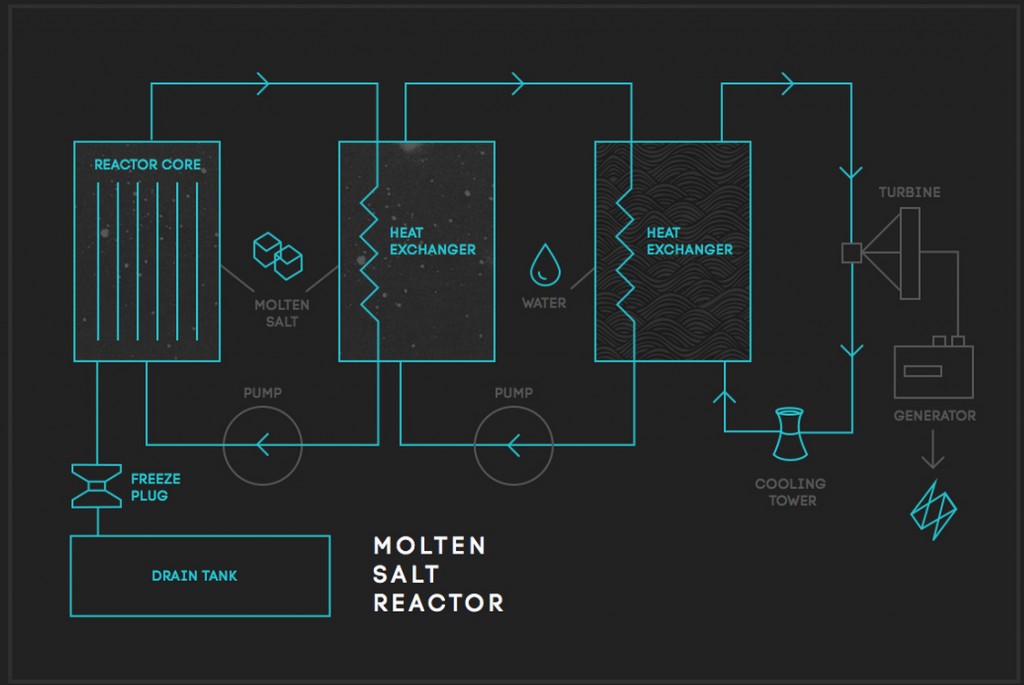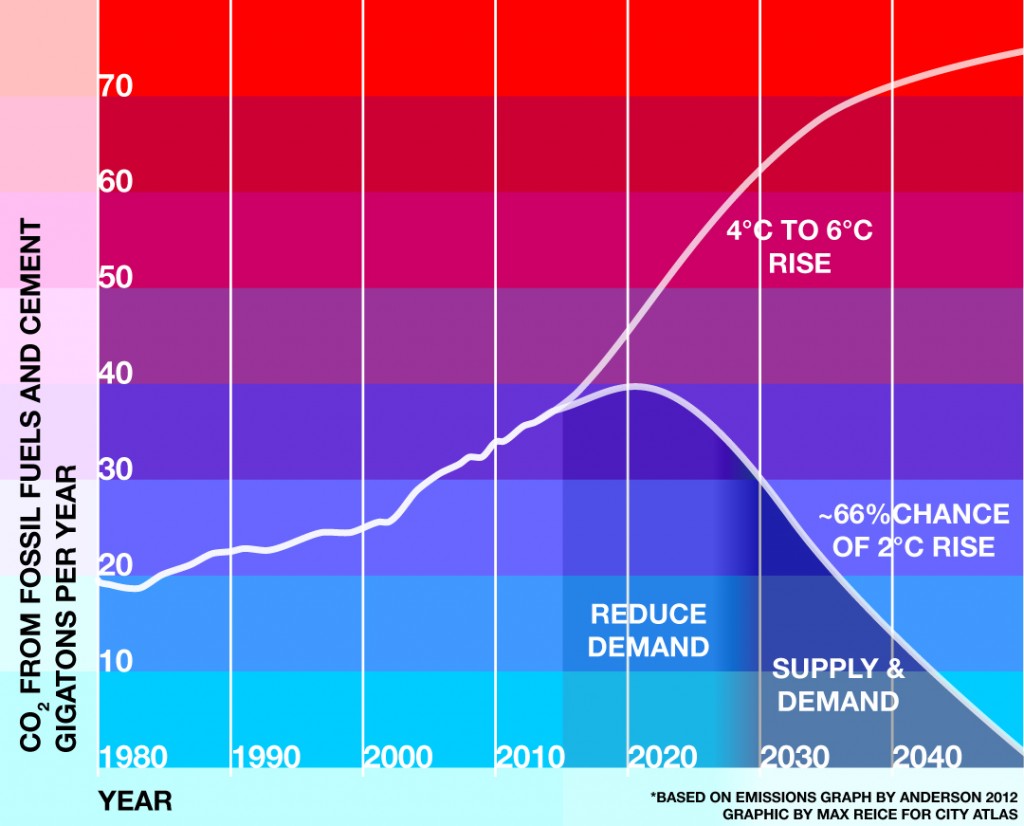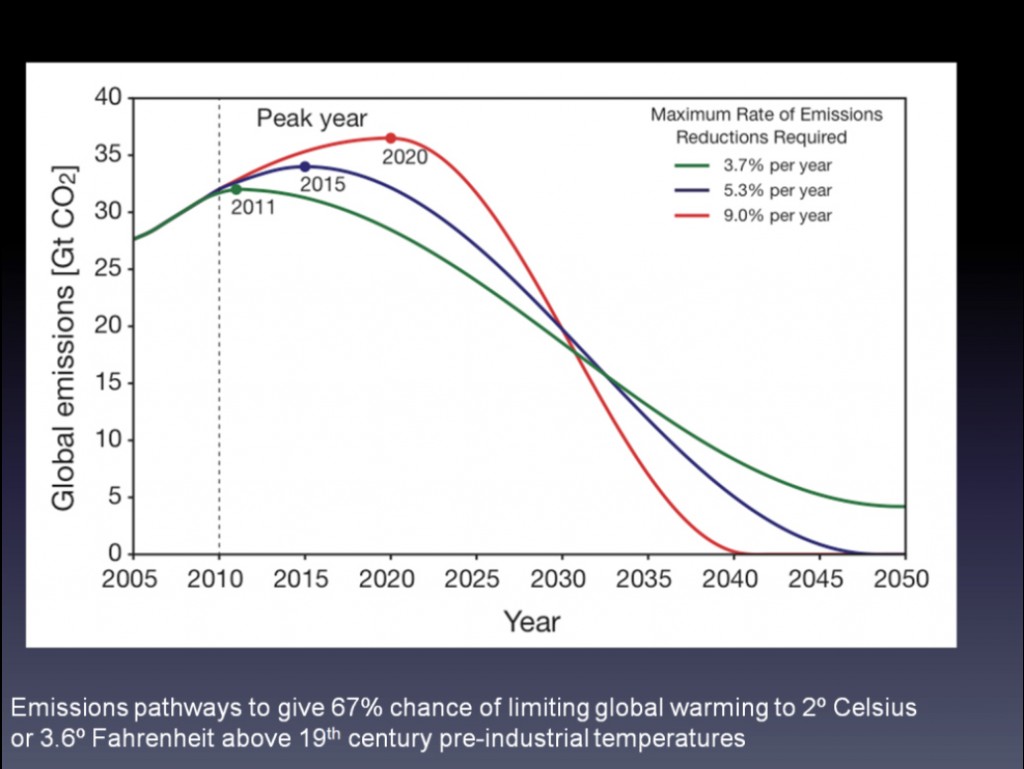After decades of talk about CO2 emissions, our civilization is still more than 80% powered by three very effective fossil fuels: coal, oil and gas – which are among the cheapest sources of power if we leave out the social cost of carbon and the $500+ billion per year in taxpayer subsidies fossil fuels receive from governments worldwide.
But the way is prepared for rapid change, as charted by downloadable reports from the International Energy Agency (IEA) and especially by the State of California, which has committed to cutting emissions 40% below 1990 levels by 2030, a path fitting to the 2°C target of climate negotiations. Governor Jerry Brown has also called for a mandate of 50% renewable power statewide by 2030.
Across the US, wind power is already competitive with coal in many areas, and the Department of Energy has an animated map showing the projected growth of wind power through 2050.
One puzzle on which top experts disagree is the role of nuclear power in providing a solution to climate change. A nuclear reactor is a huge, constant supply of power that can replace all fuels. Until new, smart power grids and energy storage can balance out intermittent sources, wind and solar rely on natural gas turbines to back them up – so with wind and solar, fossil fuels must still be burned. And we can’t continue to burn fossil fuels.
James Hansen, former director of NASA’s climate research, believes nuclear power is essential for solving climate, as it is the only source scalable to entirely replace fossil fuel in vast growing economies like China. Joseph Romm, physicist and former Acting Assistant Secretary of Energy in the Clinton Administration, has a more skeptical roundup via his blog Climate Progress. The costs and social resistance to nuclear now make it difficult to build rapidly (China is expanding its fleet of nuclear reactors, and there the concern is that building too rapidly can be risky).

New thorium designs of nuclear reactors are expected to be safer, and their advocates make claims that the designs will also prove to be reliable and affordable. Two start-up companies, Thorcon and Transatomic Power, are among those racing to demonstrate improved methods to solve the world’s energy needs with nuclear power. But public opinion, funding and time constraints may be steep barriers to expanding nuclear in Western countries, most of which are shutting down old reactors and building few new ones.
Renewable technology and storage will also improve, but a hurdle for non-nuclear sources is simply the enormous amount of energy modern societies demand. A challenge with renewables is getting a sufficient amount more energy out of them than you put into building them. An offshore wind farm to power New York City would need to be 40 miles by 40 miles in area, equal to an array of turbines off the coast of Long Island, stretching from Coney Island to Montauk and about fourteen miles deep – a huge project – and even then would still need to be supplemented by fossil fuels or balanced by a smart grid that can shift supply and demand across renewable resources around the US. Ubiquitous solar plus far more efficient storage could be part of the ultimate answer, but technology breakthroughs that are needed may be years away.
The best single overview of this conundrum might be the online Global Calculator, from a team led by the UK Department of Energy and Climate Change (DECC), which is consistent with the work of David MacKay, physicist and former science advisor to the DECC. The ‘nuclear lever’ of the calculator is described here. The underlying theme of MacKay’s research: it’s important to remember proportions, and it’s increasingly important wealthy nations begin to use less energy and cut demand while we build a zero carbon energy system as fast as possible. Behavior change is the most powerful clean technology we have.
Against this background of nuclear controversy and potential, in April Rowan Wu went to see a film aptly titled “Pandora’s Promise,” followed by a discussion led by science educator and media star Bill Nye:
The evening at Columbia started with a screening of Robert Stone’s controversial pro-nuclear documentary, “Pandora’s Promise.” Named after Pandora, the Greek goddess whose box unleashed evil into the world, the movie argues that benefits outweigh the harmful effects that have been historically associated with nuclear power. The film questions the opinions of groups that have campaigned against nuclear because of its health hazards, and argues that nuclear power will be crucial to meeting the energy needs of climate change. Several prominent activists appear, among them Stewart Brand and Richard Rhodes, and reverse their anti-nuclear beliefs, adopting a view toward a future that incorporates nuclear energy. Overall, the film strives to remove the stigma of nuclear left in the wake of disasters such as Chernobyl to present a more favorable, if one-sided, case for nuclear power as a critical alternative to fossil fuels.
The keynote address, delivered by Bill Nye “The Science Guy” was, not surprisingly, stocked with scientific content. But Nye, with his background in mechanical engineering, experience in educational entertainment, and enthusiasm for all things science, has the natural ability to simplify the most complicated aspects of quantum physics into basic concepts that even humanities majors can wrap their head around. Throughout his talk he remained relatively impartial on the divisive issue on nuclear energy. Despite the fact that pollution from coal power plants have caused vastly more deaths than nuclear accidents, he does not deny the certainty of another nuclear accident occurring if more nuclear power plants are built simply because of human error. “We have to say to ourselves, is that worth the risk?” Nye encouraged the audience as voters and taxpayers to figure out that tradeoff.
The panel discussion following “Pandora’s Promise” featured director Robert Stone, Andrew Revkin of The New York Times, Gernot Wagner of the Environmental Defense Fund, and Nye. Revkin served as an unofficial moderator, directing his own questions and audience questions at the other panelists. Predictably, Stone’s answers assumed that nuclear would be incorporated into a solution for climate change, that nuclear power is “a certainty; everything is trending into this,” but also encouraged innovation and passing on good habits to our descendants.
When asked by Revkin what his thoughts were on nuclear, Nye stated that he was “all for it,” but cited the public uncertainty and distrust around nuclear too, stating that “nobody is gonna get on it.” He also suggested a top-down system to discourage carbon production, not explicitly saying the “t-a-x word,” but instead calling it a “fee.” As an economist, Wagner agreed by stating the law of demand: “price goes up, demand goes down. Works every. Single. Time.”
Despite their range of professional backgrounds and opinions, the panelists could all agree that they had faith that given the rapid pace of technological advances, members in the audience would be able to witness a reverse in climate change within their lives.
To quote Stone, nuclear isn’t “the perfect technology, but right now…given what we’re confronted with…between now and 2050 [we grow to] 10 billion people, we’re running out of fossil fuels, and there are only a few options available to us…it’s incumbent upon us in this situation to try to throw everything upon this.”
The next day, the Sustainable Development Solutions Network hosted a workshop at Columbia entitled “Nuclear Power’s Possible Role in Lowering the Global Carbon Output.” On a panel called “Future prospects of nuclear energy” Richard Lester of MIT and Eric Loewen of GE Hitachi Nuclear Energy spoke from the perspective that nuclear power is a necessary component of reaching the 2° C temperature target for 2015. Lester explained his conviction that nuclear energy development and research is needed by visualizing energy in physical space. All of the coal that America uses in a year, Lester notes, would need to be carried on an 83,000 mile long train. To replace this coal energy with wind energy would take 200,000 miles of turbines. To replace the coal energy with nuclear would require only a 1 mile long train.
Additional reporting by Madeleine Levin; “Pandora’s Promise” event hosted by Columbia University Coalition on Sustainable Development.
An example of how time-sensitive decarbonization is, via a tweet from analyst Glen Peters of CICERO. The slower we are to begin the energy transition, the steeper the drop in emissions must be. (A fast response to this chart is to immediately choose to use less energy; substitute teleconference for air travel, bicycle for car, and make meat a smaller part of one’s diet.)
Each year of delay makes keeping below 2C harder, but when do we say that 2C is no longer feasible? #IPCC#climatepic.twitter.com/nh9BxjY9LI
— Glen Peters (@Peters_Glen) May 7, 2015
A simplified version:
//platform.twitter.com/widgets.js
Chart showing necessary reduction in demand:

See also: A summary of energy and climate options for the individual
Robert Stone describes his motivations in making the film “Pandora’s Promise” on video below:
[vimeo 125735747 w=500 h=281]
Today’s Outlook: live readout of California’s energy demand and supply from renewables.
Photo: “Andrew Revkin, Bill Nye, Robert Stone and Gernot Wagner discuss nuclear at Columbia,” taken by Anna Ablogina
